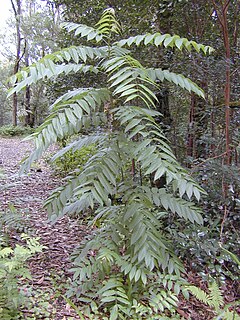Related Research Articles

Toona ciliata is a forest tree in the mahogany family which grows throughout southern Asia from Afghanistan to Papua New Guinea and Australia.

Elsholtzia ciliata, commonly known as Vietnamese balm, xiang ru (香薷) or kinh giới in Vietnamese, is a plant native to Asia. In the US, it can go by the name Crested Late Summer Mint. In US Vietnamese grocery stores, it is called Kinh Gioi, Vietnamese Lemon Balm, or Vietnamese Lemon Mint.

The Tingidae are a family of very small insects in the order Hemiptera that are commonly referred to as lace bugs. This group is distributed worldwide with about 2,000 described species.

Pseudosquilla ciliata, the common mantis shrimp, is a species of mantis shrimp, known by common names including rainbow mantis shrimp and false mantis shrimp. It is widespread in the tropical Indo-Pacific region and in both the western and eastern Atlantic Ocean.

Grindelia ciliata is a species of flowering plant in the daisy family known by the common names Spanish gold, goldenweed, and waxed goldenweed.

Populus ciliata, the Himalayan poplar, is a large deciduous tree with tall clean straight trunk and wide rounded crown. The bark of the young trees is smooth greenish-grey and the bark of the old trees is dark brown with vertical cracks. Leaves are broadly ovate with serrulate-crenate and hairy margins. Flowers are drooping raceme catkins appear before or with leaves. Populus ciliata flowers are dioecious, individual flowers are either male or female. Perianth of male flowers is bell-shaped and female flowers are bluntly toothed. Their capsule encloses an average of 100–150 seeds, which are covered by long silky hair.

Blephilia ciliata is a species of herbaceous perennial plant in the family Lamiaceae native to eastern North America. It is commonly called downy wood mint. Other common names include downy pagoda-plant, sunny woodmint and Ohio horsemint.

Crossotini is a tribe of longhorn beetles of the subfamily Lamiinae. It was described by Thomson in 1864.
Lasiocercis is a genus of longhorn beetles of the subfamily Lamiinae.
Lasiocercis pilosa is a species of beetle in the family Cerambycidae. It was described by Stephan von Breuning in 1957.
Lasiocercis rufotibialis is a species of beetle in the family Cerambycidae. It was described by Stephan von Breuning in 1957.
Lasiocercis vadoni is a species of beetle in the family Cerambycidae. It was described by Stephan von Breuning in 1957.
Lasiocercis transversefasciata is a species of beetle in the family Cerambycidae. It was described by Stephan von Breuning in 1965.
Lasiocercis truncatoides is a species of beetle in the family Cerambycidae. It was described by Stephan von Breuning in 1975.
Lasiocercis madagascariensis is a species of beetle in the family Cerambycidae. It was described by Stephan von Breuning in 1945.
Lasiocercis ochreopicta is a species of beetle in the family Cerambycidae. It was described by Stephan von Breuning in 1980.
Lasiocercis catalai is a species of beetle in the family Cerambycidae. It was described by Lepesme and Villiers in 1944.
Lasiocercis posticefasciata is a species of beetle in the family Cerambycidae. It was described by Lepesme and Villiers in 1944.
Lasiocercis fasciata is a species of beetle in the family Cerambycidae. It was described by Waterhouse in 1882.
Lasiocercis limbolaria is a species of beetle in the family Cerambycidae. It was described by Fairmaire in 1894.
References
- ↑ BioLib.cz - Lasiocercis ciliata. Retrieved on 8 September 2014.